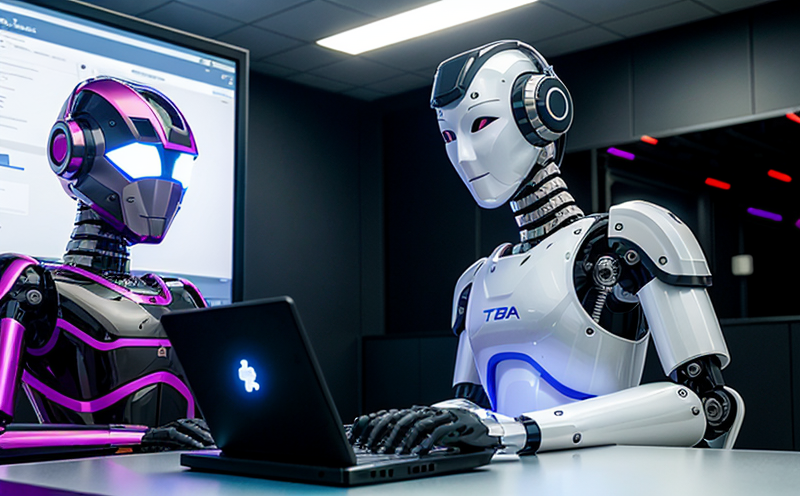ISO/IEC 27032 Cybersecurity Framework for Robotics Ecosystems
The ISO/IEC 27032 framework is designed to provide a comprehensive approach to cybersecurity in the robotics ecosystem, ensuring that data integrity and privacy are maintained throughout the lifecycle of robotic systems. This framework aligns with international standards such as ISO/IEC 27001 and focuses on the protection of information assets through various means including access control, encryption, and secure communication protocols.
The implementation of this framework is critical for organizations involved in robotics research, development, manufacturing, and deployment. It helps ensure that sensitive data is protected from unauthorized access, ensuring trust between stakeholders. By adhering to these standards, companies can enhance their reputation as reliable partners and demonstrate compliance with industry best practices.
One key aspect of ISO/IEC 27032 is its emphasis on risk management, which involves identifying potential threats early in the design process and implementing appropriate countermeasures. This proactive approach ensures that any vulnerabilities are addressed before they can be exploited by malicious actors.
To effectively implement this framework, organizations should consider several factors including:
- Identifying all relevant stakeholders within your organization who will be impacted by the cybersecurity measures
- Evaluating current processes to determine where improvements need to be made
- Developing an action plan that outlines specific steps for improving security posture
- Regularly reviewing and updating policies as necessary based on feedback from users and changing technological landscapes
The table below highlights some common use cases and application examples of this framework:
| Use Case/Example | Description |
|---|---|
| Data Encryption in Robotic Networks | This involves encrypting all data transmitted between robots within a network to prevent eavesdropping and unauthorized access. |
| Secure Software Updates | Implementing mechanisms that ensure only authorized updates are installed on robotic systems to protect against firmware tampering. |
The following list provides examples of how different sectors might benefit from adopting the ISO/IEC 27032 framework:
- Automotive: Ensuring passenger safety by protecting vehicle control systems from cyber threats.
- Healthcare: Maintaining patient confidentiality and ensuring that medical devices function correctly despite potential security breaches.
- Manufacturing: Protecting proprietary manufacturing processes from intellectual property theft while maintaining operational continuity.
In summary, the ISO/IEC 27032 framework offers a robust solution for safeguarding robotic ecosystems against various types of cyberattacks. Its emphasis on risk assessment and mitigation makes it an essential tool for any organization looking to strengthen its cybersecurity posture.
Why Choose This Test
Selecting the ISO/IEC 27032 framework test ensures that your robotics ecosystem meets stringent security requirements set forth by global standards organizations. This choice demonstrates commitment to best practices and helps build confidence among customers, partners, and investors.
By choosing this service, you're investing in long-term sustainability and resilience against emerging risks associated with connected devices. Organizations opting for these tests also gain access to expert guidance throughout the implementation process, ensuring that all necessary measures are taken correctly and efficiently.
- Achieve Compliance: Stay current with evolving regulatory requirements related to cybersecurity.
- Promote Trust: Establish credibility among stakeholders by showing leadership in information security.
- Reduce Risks: Identify and address potential weaknesses before they become critical issues.
The benefits of choosing ISO/IEC 27032 go beyond mere compliance; it offers a proactive approach to maintaining robust cybersecurity measures that contribute positively to overall business performance. With increased awareness about the importance of data protection, organizations must prioritize protecting their robotic systems from potential threats.
Implementing this framework not only enhances security but also fosters innovation by encouraging safe experimentation without fear of compromising sensitive information. This balance between safety and freedom allows for continuous improvement in both product quality and user experience.
Quality and Reliability Assurance
The ISO/IEC 27032 framework plays a crucial role in ensuring the quality and reliability of cybersecurity measures within robotic ecosystems. This section outlines key aspects that contribute to achieving these goals:
- Vulnerability Assessment: Regularly evaluating systems for potential weaknesses ensures they remain secure against new threats.
- Incident Response Planning: Establishing protocols for responding swiftly to any breaches helps minimize damage and maintain system integrity.
- Continuous Monitoring: Implementing real-time monitoring tools allows organizations to detect anomalies promptly, allowing immediate corrective actions.
A table summarizing these elements further illustrates their importance:
| Aspect | Description |
|---|---|
| Vulnerability Assessment | Involves identifying and evaluating existing vulnerabilities to prioritize remediation efforts. |
| Incident Response Planning | Details procedures for handling incidents, including containment, eradication, and recovery steps. |
These elements work together to create a resilient cybersecurity infrastructure capable of withstanding even sophisticated attacks. By focusing on continuous improvement based on lessons learned from past events, organizations can enhance their ability to withstand future challenges effectively.
In addition to the above, organizations should also consider implementing regular audits and reviews by independent third parties to ensure ongoing compliance with best practices.
Use Cases and Application Examples
The ISO/IEC 27032 framework has wide-ranging applicability across various industries. Here are some specific use cases:
| Industry Sector | Specific Use Case |
|---|---|
| Aerospace & Defense | Protecting classified data used in autonomous drones and unmanned aerial vehicles (UAVs). |
| Telecommunications | Securing network infrastructure against attacks that could disrupt critical communications services. |
The following list provides additional examples showcasing diverse applications:
- Supply Chain Management: Ensuring secure transmission of inventory data between suppliers and manufacturers.
- Smart Cities: Protecting public safety systems from cyber threats that could compromise urban infrastructure.
- E-Commerce: Safeguarding transactional information exchanged between customers and e-commerce platforms.
These examples illustrate how the ISO/IEC 27032 framework can be tailored to meet unique challenges faced by different sectors. By adapting the standards to fit specific needs, organizations can achieve better protection against cyber risks while fostering innovation within their industries.





